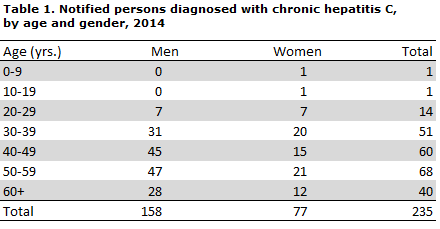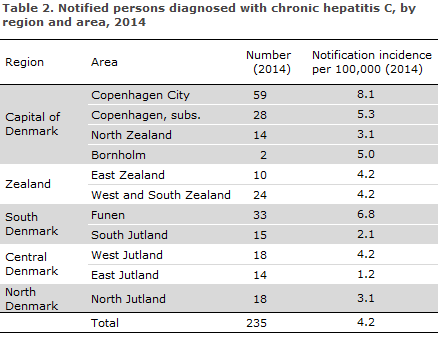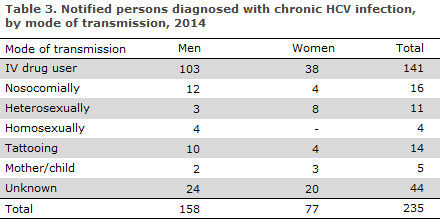No 12 - 2015
Acute and chronic hepatitis C 2014
Acute and chronic hepatitis C 2014
Acute hepatitis C
In 2014, the Department of Infectious Disease Epidemiology received 7 acute hepatitis C notifications, 5 of which concerned male cases. The median age was 39 years (range 24-42 years). Both women and three of the men had been infected in Denmark through IV drug use. One man had been infected through heterosexual contact with a prostitute in Thailand where he also contracted HIV. Another man had been infected in Denmark through homosexual contact. He was a known HIV positive.
Chronic hepatitis C
In 2014, a total of 235 cases of chronic HCV infection were notified, including 158 (67%) men. The median age was 48 years (range 2-75 years) for both men and women, Table 1.

Table 2 presents the distribution on region and area and the notification incidence per 105 citizens

Transmission
A total of 161 (68%) persons had acquired the infection in Denmark, and 49 (21%) had become infected in 26 other countries, whereas the country of infection was not stated for 25 (11%) of the cases. The mode of infection is presented in Table 3.

IV drug use was stated as the source of infection in 141 (60%) of the notified cases. Among these, 88% were acquired in Denmark.
A total of 16 persons (7%) were notified as nosocomially infected cases. This group included 3 Danes who were infected in Denmark via blood products before the introduction of HVC donor blood screening in 1991. All of the 13 nosocomially infected immigrants were infected before their arrival to Denmark.
In 11 cases, heterosexually transmitted infection was notified, including 9 cases infected in Denmark, 1 in the USA and 1 in Africa.
Among the heterosexually infected, 6 had engaged in sex with an IV drug user. Two were HIV positives.
Four had become infected through homosexual contact, all of whom were known HIV positives. One person was notified as having been infected in Denmark. In the remaining cases, the country of infection was unknown.
Tattooing was identified as the most probable mode of infection in 14 cases. In 10 cases, the person was Danish. Nine of these persons were notified as having been infected in Denmark, including 1 person who was notified as having been infected at a market in 1995 where the person was also infected with hepatitis B. The final Dane and the 4 immigrants were notified as having been infected abroad; 4 in Eastern Europe and 1 in South America.
Five persons were notified as cases of mother-to-child infection. Among these cases, 2 had been infected in Denmark, one 2 years ago and the other more than 30 years ago. The remaining 3 perons were infected in the Middle East.
Commentary
Hepatitis C rarely presents as an acute illness; it is generally only diagnosed once the chronic stage has been reached. When hepatitis C is detected in connection with screening of asymptomatic IV drug users and HIV positives, the classification of the case as either acute or chronic hepatitis C depends on whether negative tests have been performed within a short interval preceding the test by which it was detected. Therefore, the distinction between acute and chronic hepatitis C is sometimes arbitrary.
The number of notified cases is at par with that observed in recent years. It is still mainly ID drug users who are notified with hepatitis C. It is possible that some homosexually infected persons are not notified as such, but wind up in the rather large group of persons notified with an unknown mode of infection. All of the 5 homosexually infected persons and 3 of the heterosexually infected (including 2 women) persons are known HIV positives; some were notified as acute others as chronic cases of hepatitis C.
In HIV positives, sexual practices involving damage to mucous membranes and therefore a risk of bleeding seem to entail a risk of infection with hepatitis C higher than is the case for HIV negatives. It has been demonstrated that the hepatitis C risk of HIV-negative men who have sex with men (MSM) is equivalent to the risk in the background population.
There has been a slight increase in the number of notified persons who are assessed as having been infected in connection with tattooing, heterosexual contact and nosocomially. This may be due to increased awareness of hepatitis C, including increased testing activity, motivated by the new forms of treatment introduced in the course of 2014.
The slightly increased number may, however, also be coincidental; because the majority of the notifications do not include information on any symptoms, it cannot be determined to which extent the patients were tested due to symptoms or due to potential risks. The current risk of infection through tattooing is not considered to be increasing.
The American Centers for Disease Control and Prevention (CDC) recommend that the so-called baby-boomers, i.e. persons born in the 1945-1965-interval, be tested for hepatitis C. The background for this recommendation is that there may be asymptomatic cases where hepatitis C was acquired in connection with the reception of blood products prior to the introduction of hepatitis C screening in the 1990s or in connection with previous, temporary IV drug use.
In Denmark, no real prevalence studies have been carried out among the general population. But the number of persons who have hepatitis C detected via the blood donor screening scheme is decreasing and has for the past 10 years remained below 10 annual cases. Thus, there seems to be no basis for a recommendation of screening of specific generations in Denmark.
As previously, the groups who should be screened for hepatitis C are current and previous IV drug users and HIV positive patients, particularly men who have sex with men.
(I. G. Helmuth, S. Cowan, Department of Infectious Disease Epidemiology)
Link to previous issues of EPI-NEWS
18 March 2015